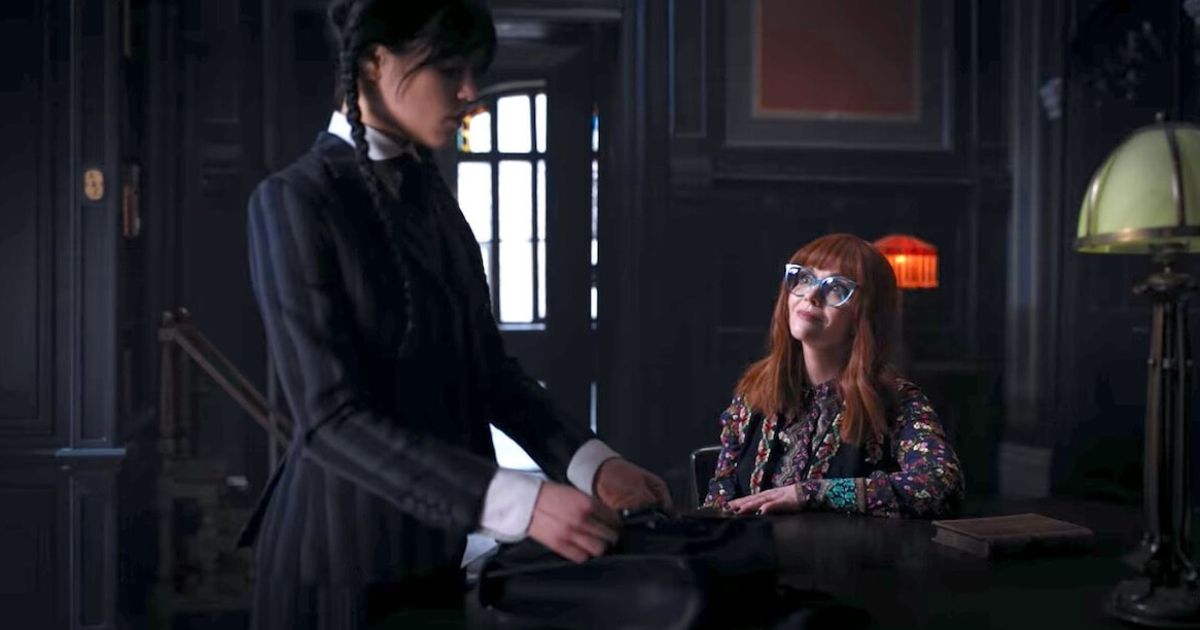Wednesday is filled with literary references that you might have missed. The Addams Family has a rich history of gothic designs, and Tim Burton had no qualms about adding to it. When Burton began working on the series, it seemed like the perfect project for an auteur of his reputation. And when we all finally saw the first episode, he had backed up Wednesday’s sadistic narcissism with a classical education that fit her character so well. She knew seven languages, was adept at playing the cello, and had an affinity for Edgar Allen Poe, as well as a wide range of other ghoulish literary facts.
Edgar Allen Poe was everywhere in Wednesday. Viewers can pick any scene randomly, and there's a high chance of hearing the word “raven.” But aside from the numerous winks at the master of the macabre, some of which are more subtle than others, Wednesday is filled with rich literary treasures often sitting right on the surface, waiting for us to recognize them. Poe, Shelley, Shakespeare, and Robert Louis Stevenson all found their way into the script in one way or another. Tim Burton brings a colorful tradition of gothic and science-fiction literature to Wednesday, perhaps hinting that Nevermore Academy’s secret libraries may be filled with more than just plot devices.
Edgar Allen Poe Is the Biggest Literary Influence in Wednesday
The most common and loudest reference we can see is Edgar Allen Poe. He even attended Nevermore Academy in this fictional universe and even helped name the school with his poem “The Raven.” That is, of course, the one work of literature the show keeps coming back to. It’s the name of the school dance; it’s the title of Wednesday's psychic abilities; it’s what Xavier Thorpe is painting in a huge mural as Wednesday walks into the school. They couldn’t have made it any clearer.
What was slightly more subtle were the names of the canoe teams in (quick eye-roll) the Poe Cup. Each team in the school was named for a different Edgar Allen Poe short story. The purple canoe, equipped with double-headed axes that try to chop Enid and Wednesday's heads off, is named for Poe’s story, “The Pit and the Pendulum.” Published in 1842, it’s about a prisoner trapped in a cell with a bottomless pit and a swinging blade slowly getting lower. Rats help him chew through his binds, and he escapes the blade. But then the walls start closing in.
Xavier and Ajax’s team is named after “The Cask of Amontillado,” a dark story of revenge in which a nobleman plots to murder a wine expert and part-time jester for insulting him. When the nobleman lures the wine expert to his cellar with the promise of a fine Amontillado, he chains him to a wall and bricks off the room, leaving him to rot. The sirens’ team, “The Gold Bug,” is a fascinating story of treasure, insanity, and brilliant cryptography.
Wednesday and Enid’s team is named “The Black Cat.” Don’t be fooled by the costumes; this tale is horrifying. The man in the story garners an obsession for black cats and is driven to mutilate them, starting with his own pet. After a series of truly grotesque tortures and the man’s house burning down, he finds another cat. In his attempts to murder this one, he accidentally kills his wife, and when he tries to hide her body, he mistakenly buries the live cat with her. The cat's cries lead the police to the slaughter, and the man is arrested.
Other Literary References
Aside from the countless allusions to Edgar Allen Poe, Wednesday also includes many other neatly packed literary treats. In the first episode, Morticia tells us that Wednesday got her name from her favorite nursery rhyme. An old English rhyme meant to help children remember the days of the week and perhaps create some superstition about the day you were born.
The full rhyme is this:
Monday's child is fair of face,
Tuesday's child is full of grace.
Wednesday's child is full of woe,
Thursday's child has far to go.
Friday's child is loving and giving,
Saturday's child works hard for a living.
And the child born on the Sabbath day
Is bonny and blithe, good and gay
In Nevermore Academy, Principal Weems assigns Wednesday to a dormitory called Ophelia Hall. Many believe this is a reference to Wednesday’s Aunt Ophelia Frump, which may be true. Still, given Wednesday’s comment, “Ophelia is the one who kills herself after being driven mad by her family,” it’s more likely that this is a reference to the Ophelia of Hamlet. She ends up going insane and drowning herself due to Hamlet and her parents’ actions. Ophelia Frump herself was also based on film representations of this character.
Later in the series, we discover the type of monster going around on its murderous rampage is called a Hyde, a reference to Robert Louis Stevenson’s “Dr. Jekyll and Mr. Hyde.” Indeed, all the students are based on various monsters from either gothic literary tradition or Greek myth. Clever that they call the Gorgons “the stoners.”
And finally, Ms. Thornhill offers Wednesday a copy of Mary Shelley’s Frankenstein. It is an apt parallel for a young prodigy who becomes an incredible fiction writer. They note that Shelley wrote her seminal novel when she was only 19 and, with it, created the entire genre of science fiction. There are certainly plenty of easter eggs hidden in Wednesday; you just have to do a bit of investigating.


.jpg)
